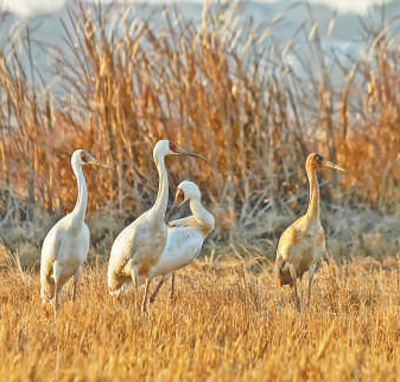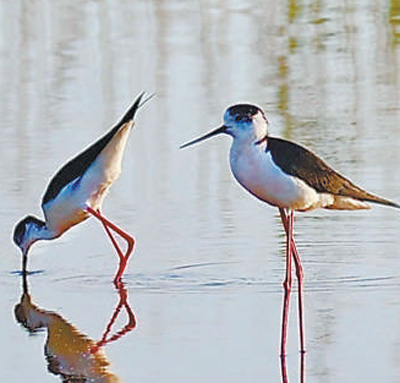China employs tech to boost conservation of migratory birds
From artificial intelligence (AI) technology to drone and algorithmic simulations, regions across China have deployed cutting-edge technologies to monitor and protect migratory birds and their habitats, especially during winter.

Migratory birds fly at the Poyang Lake National Nature Reserve in east China's Jiangxi Province. (Photo/Liu Yuanqing)
At the Poyang Lake National Nature Reserve in east China's Jiangxi Province, staff members have implemented a dual approach combining human expertise with high-tech equipment for bird monitoring.
In December 2023, the reserve established a smart management platform backed by an array of high-definition cameras and sensors that operate around the clock and AI technology to automatically identify and record bird species while calculating the density and quantity of bird flocks.
"In the past, we needed to venture deep into the lake area for on-site observation and manual patrols of birds, which was time-consuming and less accurate," said Wang Xiaolong, a ranger at the Wucheng protection station of the Poyang Lake National Nature Reserve Administration.
By presetting flight paths and inputting them into the drone inspection system, operators can now use drones to achieve comprehensive, efficient, and precise monitoring of the protected area, said Yuan Ziqi, a staff member at the Wucheng protection station. Drones have made it possible to monitor previously inaccessible marshlands and mudflats, and can issue warnings to deter activities that might harm birds or damage wetland resources.
To minimize disturbance to the birds, drones typically operate at heights above 100 meters. High-precision cameras track both bird movements and human activities while maintaining a safe distance that doesn't interfere with the birds.

Siberian cranes rest beside Poyang Lake in east China's Jiangxi Province. (Photo/Zhang Xiaolin)
The smart management system also helps optimize water levels of the lake through sophisticated simulation. By analyzing current weather conditions, water coverage, and migratory bird populations, the system can predict food availability for wintering birds and adjust water levels accordingly through sluice gates, creating favorable conditions for migratory birds.
Technology has played an equally important role at the Nandagang Wetland and Bird Nature Reserve in Cangzhou, north China's Hebei Province, which was added to UNESCO's World Heritage List in July 2024 as part of the Migratory Bird Sanctuaries along the Coast of the Yellow Sea-Bohai Gulf of China (Phase II).

Photo shows black-winged stilts at the Nandagang wetland in Cangzhou, north China's Hebei Province. (Photo/Liu Quansheng)
In recent years, the reserve has established an integrated scientific monitoring platform with an AI-enabled voiceprint recognition system, according to Zhang Jingxing, a staff member at the reserve. Unmanned, specially equipped monitoring boats in reed marshes are used to monitor birds, and real-time sound data is uploaded to the platform, which can automatically identify the species of birds.
The platform's database contains over 190,000 voiceprint recognition samples covering more than 1,500 types of bird calls.
The Nandagang wetland, which recorded over 100,000 migratory birds in 2023, now hosts 272 bird species, including 17 under first-class national protection.
An AI-powered bird monitoring system involving drones and high-definition cameras has facilitated bird observation and conservation work along Dianchi Lake in Kunming, southwest China's Yunnan Province. Researchers used to observe the birds with telescopes.

Black-headed gulls fly over Dianchi Lake in Kunming, southwest China's Yunnan Province. (Photo/Dong Rongmei)
According to Pan Min, deputy director of the Dianchi Plateau Lake Research Institute in Kunming, the use of high-definition cameras, drones and voiceprint monitoring devices has significantly improved bird data accuracy and collection efficiency.
"Results from smart monitoring devices and data from manual surveys complement each other and are integrated to provide more accurate tracking of changes in different bird species and populations during different periods," Pan added.
Photos
 Snow scenery of Shanwangping Karst national ecological park in Chongqing
Snow scenery of Shanwangping Karst national ecological park in Chongqing Anxi in SE China's Fujian develops rattan iron crafts into industrial chain worth over 10 bln yuan
Anxi in SE China's Fujian develops rattan iron crafts into industrial chain worth over 10 bln yuan Scenery of snow-covered tea plantations in Zunyi, China's Guizhou
Scenery of snow-covered tea plantations in Zunyi, China's Guizhou Woman revitalizes intangible cultural heritage items with a stylish twist
Woman revitalizes intangible cultural heritage items with a stylish twist
Related Stories
- Oriental white storks seen at wetland in SE China's Fujian
- Wintering migratory birds seen at national nature reserve, SW China's Guizhou
- Return of birds highlights Beijing's better water environment
- Black-necked cranes fly to reserve in Yunnan for wintering
- Pic story: volunteer dedicated to feeding gulls by Dianchi Lake in Kunming
- Nesting on transmission towers
- Feature: Sustained passion of bird lovers evident in SW China
- Migratory birds arrive at Caohai National Nature Reserve in SW China's Guizhou
- Migrant birds winter at Chongming Dongtan National Nature Reserve in Shanghai
- North China province sees increase in rare bird population
Copyright © 2025 People's Daily Online. All Rights Reserved.





